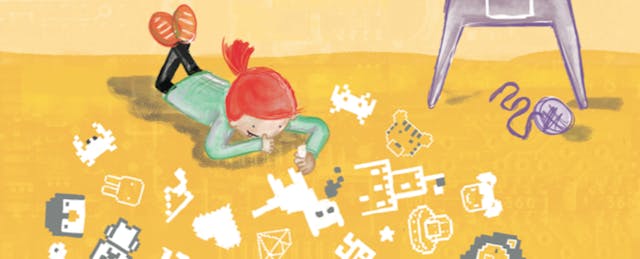Computer scientists and engineers always seem to make their way into comics. Tony Stark, haughty genius, builds himself into Iron Man; Bruce Banner, unfortunate victim of his own brilliance, becomes the Hulk; Rube Goldberg, engineer with the San Francisco Water and Sewers Department, writes America’s most popular comics and founds the National Cartoonists Society.
It’s these titanic figures that inspire today’s cartoonists—including those who come from a science background. The writers of today followed the heroes of yesterday into science. Dilbert’s Scott Adams worked a telecommunications engineer and computer programmer for 20 years. XKCD’s Randall Munroe was as a roboticist at NASA. Graphic novelist Gene Luen Yang, whom we previously interviewed, taught computer science for 17 years.
It’s no surprise, then, that some cartoonists have combined their disciplines. There are a plethora of comics aimed at teaching engineering and computer science, and it turns out they’re quite effective. In honor of CSEdWeek, we’ve rounded up our favorite engineering comics.
Hello Ruby:
Funded by a super-successful Kickstarter, Linda Liukas's “Hello Ruby” follows Ruby, a girl who loves exploring and making stuff. Her dad has hidden five gems for her to find while he’s at work. The book focuses on teaching teaching computational thinking, especially the idea of breaking big problems down into small steps. It also comes with resources that extend the lessons of the book into activities.
Super Scratch Programming Adventure:
The illustrated guide is aligned to the popular kids’ coding language Scratch. Kids read the comics and then go to Scratch’s browser interface to make a game themselves. The language uses colorful drag-and-drop blocks rather than typed commands, allowing kids to use recognizable elements to enter an unfamiliar discipline. The books creators recommend it for kids ages eight and up.
Howtoons:
These comics will teach kids how to build marshmallow guns, plastic finger extensions, and toy submarines out of common household items. They can become a mini-MacGyver! It’s also possible to buy kits that go along with the comics, so kids can read, build and play.
Meanwhile:
This choose-your-own-adventure graphic novel has 3,856 possibilities! Jimmy’s every move is in your hands, and the possibilities verge on endless. A fun and illustrative way to teach kids about statistics and probability.
Hour of Code’s Comic Creator, Tynker:
Partnering with popular toy brands like Monster High and Hot Wheels, Tynker is a series of games (not quite a comic, we cheated a little bit) for kids from pre-kindergarten to sixth grade. The interface reminds us of a comics panel, and kids can create their own games and comics within Tynker. Tynker teaches kids how to break down a problem into pieces, a central element of computational thinking. For example, while playing the Monster High for 3rd grade, we were able to throw our character’s arm at a evil skeleton, then walk one space, then walk another.
The Secret Coders:
If Harry Potter were about American kids and robots. Hopper is creeped out by her new school, but with the help of her new friend Eni, she’s able to discover commands for the weird robots patrolling her school. Author Gene Yang based the robots’ commands on Logo, the first programming language he learned. Yang also recommends Lego instructions as some of the best instructional engineering comics out there. We’re more partial to Ikea instructions.
The Manga Guide to Databases:
There is a whole series of manga guides that spans STEM subjects: physics, linear algebra, electricity, etc., each with its own hyperbolic story. In this guide, Princess Ruruna must manage the Kingdom of Kod's humongous fruit-selling empire while the king and queen are away. How will she do it? A practical fairy and a strange book are her guides to the newfound universe of databases. We were impressed by the authors’ handling of the murderous tedium of databases—this book could have been boring, but it wasn’t. Extra points for having a princess handle the database rather than a prince.
Steve Jobs, Steve Wozniak, and the Personal Computer
This one won't teach you coding, but it will teach you where your iPhone 6 came from. A look into the big personalities and minute details of hardware and coding that created Apple, Inc. Get inside the brain of Steve Wozniack, here portrayed as the technical firepower behind the cute and revolutionary computer. Learn how Steve Jobs, the marketing dynamo, captained the fledgling company. These are figures your kids probably recognize but know little about. They created some of the most important elements of contemporary computing—it's time to learn the history, and the book is better than all those b-rate movies combined. For more history, try the history of philosophical logic—the foundation of computing—and its genesis in Logicomix, a New York Times bestseller.
We’re not the only ones who thought of this: here’s a great list of single comics about coding.
BONUS: How to use comics in the classroom from Edutopia not once, but twice.


